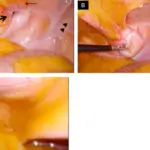Adhesions are bands of scar tissue that form between abdominal organs, mainly the small intestine. Adhesions occur after abdominal surgery and can cause your tissues to stick together.
What is the Pathology of Intestinal Adhesions?
The pathology of intestinal adhesions is:
-Etiology: The cause of intestinal adhesions is tissue incisions, contact of internal tissues with foreign materials, such as gauze, surgical gloves, and stitches.
-Genes involved: None.
-Pathogenesis: The sequence of events that lead to intestinal adhesions are: bands of fibrous tissue in the abdominal cavity that can form after abdominal or pelvic surgery, the inflammation occurs on the surface of the organ; the formation of scar tissue is a normal part of healing during inflammation. The fibrous bands are formed between tissues and organs.
-Histology: The histology associated with intestinal adhesions shows sticked scar tissues together.
How does Intestinal Adhesions Present?
Patients with intestinal adhesions typically in all genders present at any age. The symptoms, features, and clinical findings associated with intestinal adhesions include constipation, blotting, abdominal pain, nausea, and vomiting.
How is Intestinal Adhesions Diagnosed?
Intestinal adhesions is diagnosed by laparoscopy, and cannot be detected by tests or seen through imaging techniques such as x rays or ultrasound.
How is Intestinal Adhesions Treated?
Intestinal adhesions are typically not treated unless they are complications. If abdominal adhesions cause symptoms or complications, doctors can release the adhesions with laparoscopic or open surgery.
What is the Prognosis of Intestinal Adhesions?
The prognosis of intestinal adhesions is good but if adhesions cause intestinal obstruction, which then they could be life-threatening.



